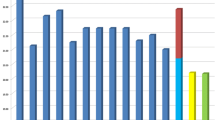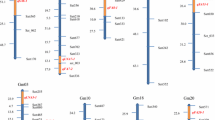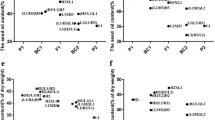Abstract
The oil accumulation in the developing soybean seed has been shown to be a dynamic process with different rates and activities at different phases affected by both genotype and environment. The objective of the present study was to investigate additive, epistatic and quantitative trait loci (QTL) × environment interaction (QE) effects of the QTL controlling oil filling rate in soybean seed. A total of 143 recombinant inbred lines (RILs) derived from the cross of Charleston and Dongnong 594 were used in this study to obtain 2 years of field data (2004 and 2005). A total of 26 QTL with significantly unconditional and conditional additive (a) effect and/or additive × environment interaction (ae) effect at different filling stages were identified on 14 linkage groups. Among the QTL with significant a effects, 18 QTL showed positive effects and 6 QTL had negative effects on seed filling rate of oil content during seed development. A total of 29 epistatic pairwise QTL underlying seed filling rate were identified at different filling stages. About 28 pairs of the QTL showed additive × additive epistatic (aa) effects and 14 pairs of the QTL showed aa × environment interaction (aae) effects at different filling stages. QTL with aa and aae (additive × additive × environment) effects appeared to vary at different filling stages. Our results demonstrated that oil filling rate in soybean seed were under genetic, developmental and environmental control.

Similar content being viewed by others
References
Allard RW (1996) Genetic basis of the evolution of adaptedness in plants. Euphytica 92:1–11
Atchley WR, Zhu J (1997) Developmental quantitative genetics, conditional epigenetic variability and growth in mice. Genetics 147:765–776
Blum A, Klueva N, Nguven H (2001) Wheat cellular thermo-tolerance is related to yield under heat stress. Euphytica 117:117–123
Cao G, Zhu J, He C et al (2001) Impact of epistasis and QTL × environment interaction on the developmental behavior of plant height in rice (Oryza sativa L.). Theor Appl Genet 103:153–160
Carlborg O, Haley CS (2004) Epistasis: too often neglected in complex trait studies? Nat Rev Genet 5:618–625
Carlborg O, De Koning DJ, Manly KF, Chesler E, Williams RW, Haley CS (2005) Methodological aspects of the genetic dissection of gene expression. Bioinformatics 21:2383–2393
Cockerham CC, Zeng ZB (1996) Design with marker loci. Genetics 143:1437–1456
Cordell HJ (2009) Detecting gene–gene interactions that underlie human diseases. Nat Rev Genet 10:392–404
Croissant GL, Torrie JH (1971) Evidence of nonadditive eff ects and linkage in two hybrid populations of soybeans. Crop Sci 11:675–677
Culverhouse R, Suarez BK, Lin J, Reich T (2002) A perspective on epistasis: limits of models displaying no main effect. Am J Hum Genet 70(2):461–471
Daynard TB, Tanner JW, Duncan WG (1971) Duration of the grain filling period and its relation to grain yield in corn, Zea mays L. Crop Sci 11:45–48
Doyle JJ, Doyle JL (1990) Isolation of plant DNA from fresh tissue. Focus 12:13–15
Egli DB (2004) Water stress, photosynthesis, seed sucrose levels and seed growth in soybean. The J Agric Sci 142:1–8
Egli DB, Legget JE, Wood JM (1978) Influence of soybean seed size and position on the rate and duration of filling. Agron J 70:127–130
Eshed Y, Zamir D (1996) Less than additive epistatic interactions of quantitative trait loci in tomato. Genetics 143:1807–1817
Frankel WN, Schork NJ (1996) Who is afraid of epistasis? Nat Genet 14:371–373
Gallardo K, Thompson R, Burstin J (2008) Reserve accumulation in legume seeds. C R Biol 331:755–762
Gebeyehou G, Knott DR, Baker RJ (1982) Rate and duration of grain filling in durum wheat cultivars. Crop Sci 22:337–340
Han Y, Teng W, Sun D, Du Y, Qiu L, Xu X, Li W (2008) Impact of epistasis and QTL × environment interaction on the accumulation of seed mass of soybean (Glycine max L. Merr.). Genet Res 90:481–491
Holland JB (2001) Epistasis and plant breeding. Plant Breed Rev 21:27–92
Hyten DL, Pantalone CE, Sams AM, Saxton D, Landau-Ellis TR, Stefaniak TR, Schmidt ME (2004) Seed quality QTL in a prominent soybean population. Theor Appl Genet 109:552–561
Jannink J-L (2003) Selection dynamics and limits under additive × additive epistatic gene action. Crop Sci 43:489–497
Jannink J-L (2008) QTL × genetic background interaction: predicting inbred progeny value. Euphytica 161:61–69
Jansen RC, Van Ooijen JW, Stam P, Lister C, Dean C (1995) Genotype by environment interaction in genetic mapping of multiple quantitative trait loci. Theor Appl Genet 91:33–37
Jiang Z, Han Y, Teng W et al. (2010) Identification of QTL underlying the filling rate of protein at different developmental stages of soybean seed. Euphytica 175(2):227–236; doi:10.1007/s10681-010-0172-5
Jones DB, Peterson ML, Geng S (1979) Association between grain filling rate and duration and yield components in rice. Crop Sci 19:641–644
Kato T (1999) Genetic and environmental variations and associations of the characters related to the grain-filling process in rice. Plant Prod Sci 2:32–36
Koutroubasa SD, Papakostab DK (2010) Seed filling patterns of safflower: genotypic and seasonal variations and association with other agronomic traits. Indust Crops Prod 31:71–76
Lark KG, Chase K, Adler FR, Mansur LM, Orf JJ (1995) Interactions between quantitative trait loci in soybean in which trait variation at one locus is conditional upon a specific allele at another. Proc Natl Acad Sci USA 2:4656–4660
Li SB, Zhang ZH, Hu Y, Li CY, Jiang X, Mao T, Li YS, Zhu YG (2006) Genetic dissection of developmental behavior of crop growth rate and its relationships with yield and yield related traits in rice. Plant Sci 170(5):911–917
Li W, Sun D, Du Y, Zhang Z, Qiu L, Sun G (2007) Quantitative trait loci underlying the development of seed composition in soybean (Glycine max L. Merr.). Genome 50:1067–1077
Liu P, Zhu J, Lu Y (2004) Marker-assisted selection in segregating generations of self-fertilizing crops. Theor Appl Genet 109:370–376
Liu ZH, Tang JH, Wang CL et al (2007) QTL analysis of plant height under N-stress and N-input at different stages in maize. Acta Agron Sin 33(5):782–789
Liu GF, Zeng RZ, Zhu HT et al (2009) Dynamic expression of nine QTLs for tiller number detected with single segment substitution lines in rice. Theor Appl Genet 118:443–453
Lu CF, Shen LS, Tan ZB, Xu YB, He P, Chen Y, Zhu LH (1997) Comparative mapping of QTLs for agronomic traits of rice across environments by using a doubled-haploid population. Theor Appl Genet 94:145–150
Luo LJ, Li ZK, Mei HW, Shu QY, Tabien R, Zhong DB, Ying CS, Stansel JW, Khush GS, Paterson AH (2001) Overdominant epistatic loci are the primary genetic basis of inbreeding depression and heterosis in rice. II. Grain yield components. Genetics 158:1755–1771
Malmberg RL, Held S, Waits A, Mauricio R (2005) Epistasis for fitness-related quantitative traits in Arabidopsis thaliana grown in the field and in the greenhouse. Genetics 171:2013–2027
Martin SK, Xie FT, Zhang HJ et al (2009) Epistasis for quantitative traits in crosses between soybean lines from China and the United States. Crop Sci 49:20–28
Mashiringwani NA, Mashingaidze K, Kangai J, Olsen K (1994) Genetic basis of grain filling rate in wheat (Triticum aestivum L. emend. Thell.). Euphytica 76:33–44
Moore J, Williams S (2009) Epistasis and its implications for personal genetics. Am J Hum Genet 85:309–320
Morandi EN (1990) Photoperiodically induced changes in seed growth rate of soybean as related to endogenous concentrations of ABA and sucrose in seed tissues. Annal Bot 66:605–611
Motzo R, Giunta F, Deidda M (1996) Relationships between grain-filling parameters, fertility, earliness and grain protein of durum wheat in a Mediterranean environment. Field Crops Res 47:129–142
Mou B, Kronstad WE, Saulescu NN (1994) Grain filling parameters and protein content in selected winter wheat populations: II. Associations. Crop Sci 34:838–841
Munier-Jolain NG, Bertrand Ney (1998) Seed growth rate in grain legumes II. Seed growth rate depends on cotyledon cell number. J Exp Bot 49:1971–1978
Nass HG, Reiser B (1975) Grain filling period and grain yield relationships in spring wheat. Can J Plant Sci 55:673–678
Ohno Y, Tanase H, Nabika T, Otsuda K, Sasaki T, Suzawa T, Korii T, Yamori Y, Saruta T (2000) Selective genotyping with epistasis can be utilized for a major quantitative trait locus mapping in hypertension in rats. Genetics 155:785–792
Orf JH, Chase K, Adler FR, Mansur LM, Lark KG (1999a) Genetics of soybean agronomic traits: II. Interactionsbetween yield quantitative trait loci in soybean. Crop Sci 39:1652–1657
Orf JH, Chase K, Jarvik T, Mansur LM, Cregan PB, Adler FR, Lark KG (1999b) Genetics of soybean agronomic traits: I. Comparison of three related recombinant inbred populations. Crop Sci 39:1642–1651
Paterson A, Damon S, Hewitt J, Zamir D, Rabinowitch H, Lincoln S, Lander E, Tanksley SD (1991) Mendelian factors underlying quantitative traits in tomato: comparison across species, generations, and environments. Genetics 127:181–197
Pfeiffer TW, Egli DB (1988) Heritability of seed-filling period estimates in soybean. Crop Sci 28:921–925
Poneleit CG, Egli DB (1979) Kernel growth rate and duration in maize as affected by plant density and genotype. Crop Sci 19:385–388
Rasmusson DC, Phillips RL (1997) Plant breeding progress and genetic diversity from de novo variation and elevated epistasis. Crop Sci 37:303–310
Ray S, Choudhuri MA (1981) Effects of plant growth regulators on grain-filling and yield of rice. Ann Bot 47:755–758
Schmutz J, Cannon SB, Schlueter J et al (2010) Genome sequence of the palaeopolyploid soybean. Nature 463(7278):178–183. doi:10.1038/nature08670
Schussler JR (1984) Abscisic acid and its relationship to seed filling in soybeans. Plant Physiol 76(2):301–306
Smith JR, Nelson RL (1986a) Selection for seed-filling period in soybean. Crop Sci 26:466–469
Smith JR, Nelson RL (1986b) Relationship between seed-filling period and yield among soybean breeding lines. Crop Sci 26:469–472
Song QJ, Marek LF, Shoemaker RC, Lark KG, Concibido VC, Delannay X, Specht JE, Cregan PB (2004) A new integrated genetic linkage map of the soybean. Theor Appl Genet 109:122–128
Soxhlet F (1879) Die gewichtsanalytische Bestimmung des Milchfettes. Polytechnisches J 232:461–465
Specht JE, Chase K, Macrander M, Graef GL, Chung J, arkwell JP et al (2001) Soybean response to water: a QTL analysis of drought tolerance. Crop Sci 41:493–509
Stuber CW, Lincoln SE, Wolff DW, Helentjaris T, Lander ES (1992) Identification of genetic factors contributing to heterosis in a hybrid from two elite maize inbred lines using molecular markers. Genet 132:823–839
Sun D, Li W, Zhang Z, Chen Q, Ning H, Qiu L, Sun G (2006) Quantitative trait loci analysis for the developmental behavior of soybean (Glycine max L. Merr.). Theor Appl Genet 112:665–673
Talbert LE, Lanning SP, Murphy RL, Martin JM (2001) Grain fill duration in twelve hard red spring wheat crosses: genetic variation and association with other agronomic traits. Crop Sci 41:1390–1395
Teng W, Han Y, Du Y, Sun D, Zhang Z, Qiu L, Sun G, Li W (2009) QTL analyses of seed weight during the development of soybean (Glycine max L. Merr.). Heredity 102(4):372–380
Thorne JH (1981) Morphology and ultrastructure of maternal seed tissues of soybean in relation to the import of photosynthesis. Plant Physiol 67:1016–1025
Trigizano RN, Caetano-Anolles G (1998) Laboratory exercises on DNA amplification fingerprinting for evaluating the molecular diversity of horticultural species. Hort Technol 8:413–423
Wang DL, Zhu J, Li ZK, Paterson AH (1999a) Mapping QTLs with epistatic effects and QTL environment interactions by mixed linear model approaches. Theor Appl Genet 99:1255–1264
Wang GL, Kang MS, Moreno O (1999b) Genetic analyses of grain-filling rate and duration in maize. Field Crops Res 61:211–222
Wang ZH, Wu XSH, Ren Q, Chang XP, Li RZH, Jing RL (2010) QTL mapping for developmental behavior of plant height in wheat (Triticum aestivum L). Euphytica 174(3):447–458. doi:10.1007/s10681-010-0166-3
Wilfert L, Schmid-Hempel P (2008) The genetic architecture of susceptibility to parasites. BMC Evol Biol 8:187
Wu WR, Li WM, Tang DZ et al (1999) Time-related mapping of quantitative trait loci underlying tiller number in rice. Genetics 151:297–303
Yan JQ, Zhu J, He CX et al (1998) Quantitative trait loci analysis for the developmental behavior of tiller number in rice. Theor Appl Genet 97:267–274
Yang GH, Xing YZ, Li SQ et al (2006a) Molecular dissection of developmental behavior of tiller number and plant height and their relationship in rice (Oryza sativa L.). Hereditas 143:236–245
Yang JC, Zhang JH, Liu K et al (2006b) Abscisic acid and ethylene interact in wheat grains in response to soil drying during grain filling. New Phytol 171:293–303
Yang J, Zhu J, Williams RW (2007) Mapping the genetic architecture of complex traits in experimental populations. Bioinformatics 23:1527–1536
Yang W, Peng S, Dionisio-Sese ML, Laza RC, Visperas RM (2008) Grain filling duration, a crucial determinant of genotypic variation of grain yield in field-grown tropical irrigated rice. Field Crops Res 105:221–227
Yu SB, Li JX, Xu CG, Tan YF, Gao YJ, Li XH, Zhang Q, Maroof MAS (1997) Importance of epistasis as the genetic basis of heterosis in an elite rice hybrid. Proc Natl Acad Sci USA 94:9226–9231
Zhu J (1995) Analysis of conditional genetic effects and variance components in developmental genetics. Genetics 141:1633–1639
Zhu J (1999) Mixed model approaches of mapping genes for complex quantitative traits. J Zhejiang Univ (Nat Sci edition) 33:327–335
Acknowledgments
This work was conducted in the Key Laboratory of Soybean Biology of Chinese Education Ministry and Soybean Development Centre of Agricultural Ministry, financially supported by National High Technology Project (2006AA10Z1F1 and 2006AA100104-4), National Nature Science Foundation projects (30971810, 60932008), National 973 Project (2009CB118400) and Provincial Education Ministry for the team of soybean molecular design.
Author information
Authors and Affiliations
Corresponding author
Additional information
The authors Zhenfeng Jiang and Binbin Zhang have equal contribution to this paper.
Rights and permissions
About this article
Cite this article
Jiang, Z., Zhang, B., Teng, W. et al. Impact of epistasis and QTL × environmental interaction on the oil filling rate of soybean seed at different developmental stages. Euphytica 177, 431–442 (2011). https://doi.org/10.1007/s10681-010-0290-0
Received:
Accepted:
Published:
Issue Date:
DOI: https://doi.org/10.1007/s10681-010-0290-0




